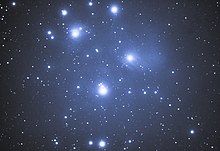
Back عنقود مفتوح Arabic Cúmulu abiertu AST Açıq ulduz topası Azerbaijani Таралған йондоҙҙар тупланмаһы Bashkir Рассеянае зорнае скопішча Byelorussian Расьсеяная зорная скупнасьць BE-X-OLD Разсеян звезден куп Bulgarian মুক্ত স্তবক Bengali/Bangla Otvoreno zvjezdano jato BS Cúmul obert Catalan
| Open cluster | |
|---|---|
 The Pleiades is one of the most famous open clusters. | |
| Characteristics | |
| Type | Loose cluster of stars |
| Size range | < 30 ly in diameter |
| Density | ~ 1.5 stars / cubic ly |
| External links | |
| Additional Information | |
An open cluster is a type of star cluster made of tens to a few thousand stars that were formed from the same giant molecular cloud and have roughly the same age. More than 1,100 open clusters have been discovered within the Milky Way galaxy, and many more are thought to exist.[1] Each one is loosely bound by mutual gravitational attraction and becomes disrupted by close encounters with other clusters and clouds of gas as they orbit the Galactic Center. This can result in a loss of cluster members through internal close encounters and a dispersion into the main body of the galaxy.[2] Open clusters generally survive for a few hundred million years, with the most massive ones surviving for a few billion years. In contrast, the more massive globular clusters of stars exert a stronger gravitational attraction on their members, and can survive for longer. Open clusters have been found only in spiral and irregular galaxies, in which active star formation is occurring.[3]
Young open clusters may be contained within the molecular cloud from which they formed, illuminating it to create an H II region.[4] Over time, radiation pressure from the cluster will disperse the molecular cloud. Typically, about 10% of the mass of a gas cloud will coalesce into stars before radiation pressure drives the rest of the gas away.
Open clusters are key objects in the study of stellar evolution. Because the cluster members are of similar age and chemical composition, their properties (such as distance, age, metallicity, extinction, and velocity) are more easily determined than they are for isolated stars.[1] A number of open clusters, such as the Pleiades, the Hyades and the Alpha Persei Cluster, are visible with the naked eye. Some others, such as the Double Cluster, are barely perceptible without instruments, while many more can be seen using binoculars or telescopes. The Wild Duck Cluster, M11, is an example.[5]
- ^ a b Cite error: The named reference
sedswas invoked but never defined (see the help page). - ^ Cite error: The named reference
Karttunen_et_al_03was invoked but never defined (see the help page). - ^ Cite error: The named reference
payne-gaposchkin79was invoked but never defined (see the help page). - ^ Cite error: The named reference
apj62was invoked but never defined (see the help page). - ^ Cite error: The named reference
neata09was invoked but never defined (see the help page).
© MMXXIII Rich X Search. We shall prevail. All rights reserved. Rich X Search